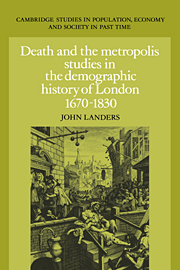Book contents
- Frontmatter
- Contents
- List of figures and maps
- List of tables
- Preface
- Acknowledgements
- Part I EIGHTEENTH-CENTURY LONDON AND ITS VITAL REGIME
- Part II THE LEVEL OF MORTALITY
- Part III DIMENSIONS OF LONDON'S EPIDEMIOLOGICAL REGIME
- Appendices
- Bibliography
- Index
- Cambridge Studies in Population Economy and Society in Past Time
Part III - DIMENSIONS OF LONDON'S EPIDEMIOLOGICAL REGIME
Published online by Cambridge University Press: 05 November 2011
- Frontmatter
- Contents
- List of figures and maps
- List of tables
- Preface
- Acknowledgements
- Part I EIGHTEENTH-CENTURY LONDON AND ITS VITAL REGIME
- Part II THE LEVEL OF MORTALITY
- Part III DIMENSIONS OF LONDON'S EPIDEMIOLOGICAL REGIME
- Appendices
- Bibliography
- Index
- Cambridge Studies in Population Economy and Society in Past Time
Summary
There has as yet, however, been little detailed research into the explicitly quantitative incidence of disease, or of specific infections, in the late eighteenth and nineteenth centuries.
(Luckin 1980: 54)In the preceding sections we have considered the pattern of aggregate vital data from eighteenth-century London and tried to estimate the prevailing levels of fertility and mortality. The results generally bore out the ‘high potential’ interpretation of metropolitan epidemiology, but if we are to pursue this question any further we must move from a study of the ‘output’ variable – the medium-term level of mortality – to one of the ‘internal’ character of the regime itself. This involves a consideration of the intermediate mortality variables, their structure and inter-relationships, together with London's pathogenic load over our period.
The latter is, of course, crucial for the proximate explanation of mortality patterns in any population, but assumes prime importance when we consider relationships between metropolitan epidemiological regimes and those of their hinterlands. The HPM portrays the former as endemic reservoirs of infection – sources of epidemic crises in the hinterland – whose distinctive character reflects quantitative differences in the incidence of infections common to both metropolis and hinterland, rather than the action of diseases peculiar to the former. In particular, the model implies that excess urban mortality arose substantially from infections communicated from person to person, either directly or by the action of arthropod vectors.
- Type
- Chapter
- Information
- Death and the MetropolisStudies in the Demographic History of London, 1670–1830, pp. 197 - 202Publisher: Cambridge University PressPrint publication year: 1993



